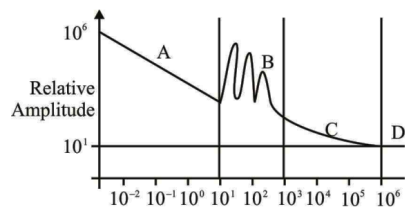31. From the following relative amplitude vs frequency plot, identify the type of noise which the sections A, B, C and D depict.

List-I
List-II
a. Section A
1. Thermal noise
b. Section B
2. Power line pick up
c. Section C
3. Power supply (EPC) switching noise
d. Section D
4. $$\frac{1}{{\text{f}}}$$ noise

| List-I | List-II |
| a. Section A | 1. Thermal noise |
| b. Section B | 2. Power line pick up |
| c. Section C | 3. Power supply (EPC) switching noise |
| d. Section D | 4. $$\frac{1}{{\text{f}}}$$ noise |
32. For an ideal 3000 Hz channel, nyquist rate is
33. Which of the following is not the modulation technique
34. The information rate to be transmitted is 900 bits/sec, FEC is $$\frac{3}{4}$$, the symbol rate for QPSK modulation scheme is:
35. Flat top sampling of low pass signals
36. In a binary PCM system, the maximum tolerable error is sample amplitudes is 0.5% of the peak input signal amplitude. The input signal bandwidth is 5 MHz. The minimum rate of transmission of the PCM coded bits is:
37. The bit rate of a digital communication system is 34 Mbit/s. The modulation scheme is QPSK. The baud rate of the system is
38. What is the process of utilizing one data link for transmission of a group of variable known as?
39. In a single error correcting Hamming code, the number of message bits in a block is 26. The number of check bits in the block would be
40. A satellite system employs QPSK modulation with 40% excess bandwidth per carrier including guard band. The voice channels use 64 kbps PCM coding. The number of channels supported by 36 MHz bandwidth of the transponder in bandwidth limited case will be
Read More Section(Digital Communication)
Each Section contains maximum 100 MCQs question on Digital Communication. To get more questions visit other sections.
